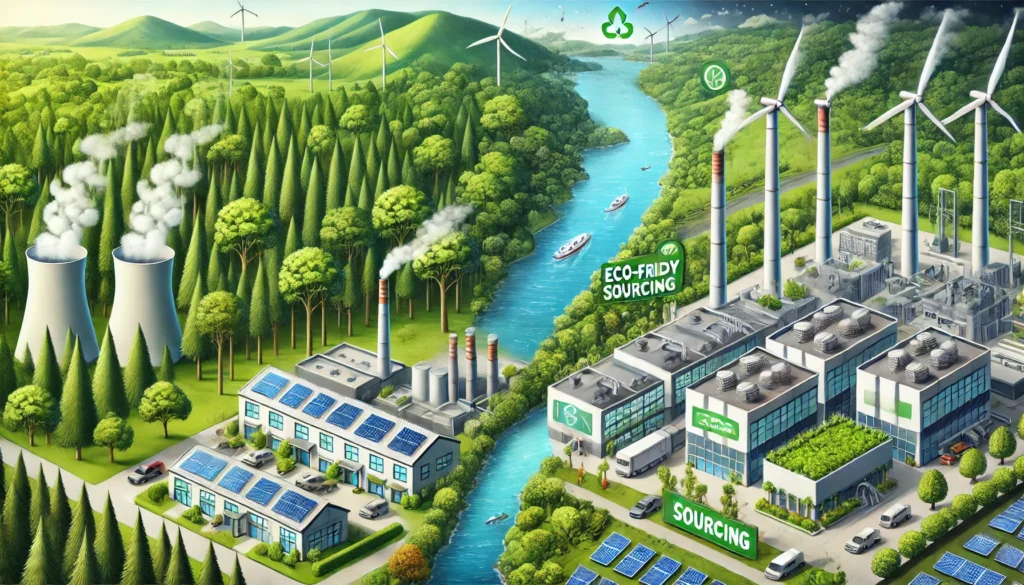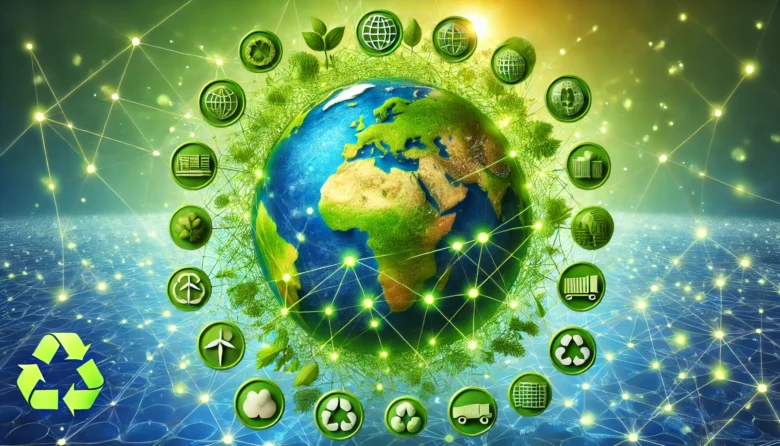In today’s rapidly evolving business world, sustainability is no longer just a buzzword—it’s a powerful strategy to create resilient and profitable companies. Businesses around the world are increasingly recognizing that sustainable supply chains are essential not only for reducing environmental impact but also for building customer trust, cutting costs, and mitigating risks. So, what exactly does it take to build a sustainable supply chain? Let’s dive in.
Understanding the Basics: What Is a Sustainable Supply Chain?
A sustainable supply chain refers to the integration of environmentally and socially responsible practices across every stage of a business’s supply network, from sourcing raw materials to delivering the finished product. In essence, it’s about making smart choices that help reduce a company’s carbon footprint and promote ethical labour practices. For instance, using renewable energy, reducing waste, and adopting eco-friendly materials are all practices that contribute to supply chain sustainability.
A real-world example comes from Patagonia, a California-based outdoor clothing company that has set the standard for sustainable practices. Patagonia’s commitment to recycling materials, avoiding hazardous chemicals, and supporting fair labour practices has helped it build a loyal customer base while reducing its environmental impact.
Why Should Businesses Invest in Sustainable Supply Chains?
Cost Savings and Efficiency
Reducing waste and optimizing resources often result in significant cost savings. For instance, Unilever (a global consumer goods company recognized for brands like Dove and Lipton) introduced its “Sustainable Living Plan” to work towards reducing its environmental impact by half. By streamlining its manufacturing processes and reducing water and energy use, Unilever has saved millions of dollars in production costs. Sustainable practices can also help companies avoid costly fines and taxes associated with environmental regulations.
Enhanced Brand Image and Customer Loyalty
With consumers increasingly prioritizing eco-friendly choices, a sustainable supply chain can offer companies a distinctive advantage. Companies like Tesla (an electric vehicle manufacturer) have built their brand around environmental stewardship, appealing to consumers who prioritize sustainability. By investing in renewable energy, ethical sourcing, and low-emission technology, Tesla has established itself as a leader in sustainable innovation. This approach resonates strongly with customers, fostering loyalty and enhancing the company’s brand image.

Risk Management and Compliance
Environmental disasters, human rights violations, or regulatory non-compliance can disrupt a supply chain and harm a brand’s reputation. Sustainable supply chains are designed to mitigate these risks. For example, Apple (a technology company known for iPhones and Mac computers) has implemented strict guidelines for suppliers to reduce environmental impact and ensure fair working conditions. Apple regularly audits its suppliers and provides transparency reports to hold them accountable.
How to Build a Sustainable Supply Chain
Conduct a Supply Chain Assessment
Before making any changes, it’s essential to understand the current state of your supply chain. A supply chain assessment involves mapping out each step and identifying areas with high energy consumption, waste, or unethical practices. Some companies even work with third-party auditors or use tools like the EcoVadis platform, which helps businesses assess sustainability across their supply chain. Once you have a comprehensive understanding, you can establish specific targets and track progress consistently.
Choose Eco-Friendly Materials and Partners
Selecting sustainable materials and working with environmentally responsible suppliers are critical steps in creating a greener supply chain. For instance, IKEA (a Swedish multinational known for affordable furniture) has committed to using only renewable or recycled materials by 2030. By sourcing materials like bamboo, which regenerates faster than trees, IKEA is creating more sustainable products and fostering a greener supply chain.
Invest in Green Technologies
Green technology, such as renewable energy sources and waste-reduction innovations, plays a significant role in supply chain sustainability. For example, Walmart (a multinational retail corporation) has committed to sourcing 50% of its energy from renewable sources by 2025 and reducing supply chain emissions. Through investments in solar power and energy-efficient transportation, Walmart is setting an example for large-scale retailers.
Embrace Circular Economy Principles
The circular economy focuses on reducing waste and maximizing the efficient use of resources. It’s about keeping products, materials, and resources in use for as long as possible. Dell Technologies (a computer hardware company) has integrated circular economy principles by designing products that are easy to recycle and using recovered materials in new products. This practice not only reduces waste but also reduces the cost of raw materials.
Empower and Educate Your Workforce
The success of any sustainable initiative depends on the people involved. Training employees on the importance of sustainability and implementing incentive programs for green practices can go a long way. Take Starbucks (a coffeehouse chain) as an example; they engage their employees, or “partners,” in their sustainability efforts by offering training on responsible sourcing, recycling, and waste reduction. Empowered employees often bring innovative ideas that can make a real difference.
Real-World Case Studies: Who’s Leading the Way?
Nike: Moving Toward Zero Carbon and Zero Waste
Nike, Inc., the American sportswear giant, has a long-standing sustainability initiative called “Move to Zero,” aiming for zero carbon and zero waste. Nike has reduced its carbon emissions by increasing the use of recycled materials and investing in more energy-efficient facilities. The company’s “Grind” program collects used athletic shoes to create new products, showing a clear commitment to a circular economy.
Danone: Sourcing Responsibly
Danone, a multinational food-products corporation known for brands like Evian and Activia, has committed to sustainable agriculture by partnering with local farmers and sourcing ingredients responsibly. Through the “One Planet. One Health” initiative, Danone promotes biodiversity and organic farming practices, which support ecosystem preservation and fair wages for farmers.
Challenges and Solutions in Sustainable Supply Chains
While the benefits are clear, implementing sustainable supply chains comes with challenges. Small to medium-sized businesses, in particular, may face financial constraints and limited access to green technologies. However, various government incentives, grants, and industry partnerships are now available to support these businesses in going green. Additionally, working with third-party certifiers, such as Fair Trade and Rainforest Alliance, can help companies ensure their practices are ethical and sustainable without needing extensive resources.
Conclusion: Taking the First Steps Toward a Greener Supply Chain
Transitioning to a sustainable supply chain is not an overnight process—it’s a journey that requires commitment, creativity, and collaboration. Whether it’s reducing waste, choosing eco-friendly materials, or educating your workforce, every small step counts. Sustainable practices not only contribute to preserving our environment but also support long-term financial success and strengthen brand loyalty. Businesses of all sizes have a role to play, and it all starts with understanding the impact of their choices.
Call to Action
If you’re a business leader, now is the time to assess your supply chain practices and consider making changes that benefit both your company and the planet. The demand for sustainable practices is here to stay, and those who act on it will be the leaders of tomorrow.
Author’s Note:
Sustainable business practices are more than a trend; they are the future. I hope this guide inspires businesses to rethink their supply chains and make decisions that create positive, lasting change.
G.C., Ecosociosphere contributor.
References and Further Reading:
- The Sustainable Development Goals (SDGs) – United Nations
- Ecovadis – Sustainable Supply Chain Ratings
- Sustainable Practices for Store Managers. https://professionsinuk.com/store-managers-sustainable-practices/
- Sustainable Manufacturing: Balancing Profit with Environmental Responsibility – Supanet. https://www.supanet.com/sustainable-manufacturing-balancing-profit-with-environmental-responsibility-a28012.html
- Sustainability | Building a Greener Future for Generations to Come. https://studiobybp.com/sustainability/
- Eco-Friendly Hotel might be your way to prosperity. https://blog.guestbell.com/2023/01/16/eco-friendly-hotels-a-path-to-prosperity/
- Five steps to achieving a sustainable data center supply chain. https://blog.se.com/datacenter/2022/06/01/five-steps-sustainable-data-center-supply-chain/




